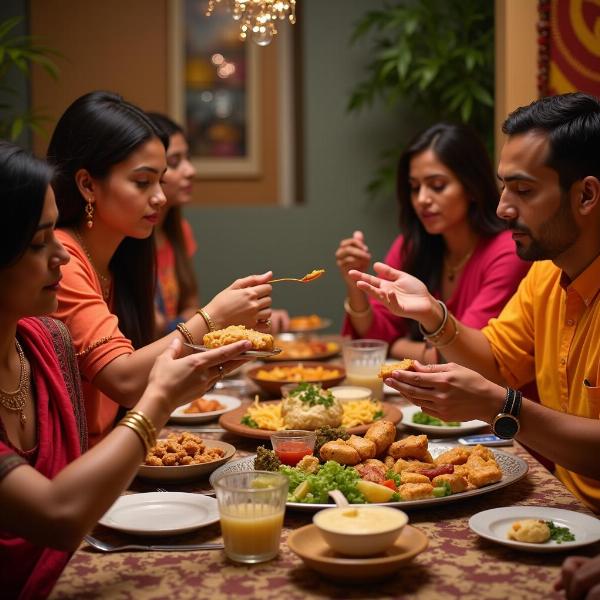Feasting, a concept deeply intertwined with human culture, finds a rich and varied expression in the Hindi language and Indian traditions. Understanding “feasting meaning in Hindi” goes beyond simple translation; it requires exploring the cultural nuances, religious significance, and social importance attached to shared meals and celebratory occasions. This article delves into the various terms, customs, and contexts that encompass the essence of feasting in Hindi, providing a comprehensive understanding of its multifaceted nature.
The Heart of Feasting: From Everyday Meals to Grand Celebrations
In Hindi, the concept of feasting can be expressed through various words, each carrying its own shade of meaning. While “bhoj” (भोज) generally refers to a formal feast or banquet, often associated with religious ceremonies or large gatherings, “daawat” (दावत) implies a more personal invitation to a celebratory meal, often hosted in someone’s home. The term “khaana” (खाना), while commonly used for any meal, can also signify a feast, especially when referring to a particularly elaborate or abundant spread. “Ziyafat” (ज़ियाफ़त) denotes a grand feast, often hosted by royalty or dignitaries. These terms reflect the diverse spectrum of feasting in Hindi, ranging from everyday meals shared with family to lavish celebrations marking important milestones.
Religious and Cultural Significance of Feasting in India
Feasting plays a crucial role in many Indian religious and cultural festivals. Diwali, the festival of lights, is marked by elaborate feasts and the exchange of sweets. Eid-ul-Fitr, celebrated by Muslims, culminates in grand feasts after a month of fasting. Similarly, Christmas celebrations in India often involve festive meals with family and friends. These feasts not only offer a time for indulgence but also symbolize community, sharing, and gratitude.
Feasting Etiquette and Traditions in India
Indian feasting traditions are steeped in cultural etiquette. Guests are often served first, and it’s considered polite to accept food with the right hand. Sharing food is a common practice, and it’s seen as a gesture of affection and respect. The specific dishes served at a feast vary depending on the region and occasion, but they often include a variety of curries, rice, bread, and desserts.
 Indian Feasting Etiquette
Indian Feasting Etiquette
Feasting and Social Connections: Strengthening Bonds Through Shared Meals
Feasting in India is not just about the food; it’s about the social connections it fosters. Sharing a meal is an opportunity to strengthen bonds with family and friends, build relationships with new acquaintances, and celebrate life’s joys. The communal nature of feasting reinforces a sense of belonging and togetherness, making it an integral part of Indian social life.
The Evolution of Feasting in Modern India
While traditional feasting customs continue to be observed, modern India has seen a shift in feasting trends. Catered events, restaurant celebrations, and fusion cuisine are becoming increasingly popular, reflecting the changing lifestyles and culinary preferences. However, the core values of sharing, community, and celebration remain at the heart of feasting, irrespective of the format.
Conclusion: Feasting – A Celebration of Life, Culture, and Community
“Feasting meaning in Hindi” encompasses a rich tapestry of culinary traditions, cultural practices, and social values. From the simple joy of sharing a meal with family to the grandeur of a festival celebration, feasting represents a fundamental aspect of Indian life, connecting people through food and strengthening the bonds of community.
FAQ
-
What is the most common word for “feast” in Hindi?
- While several words convey the idea of a feast, “bhoj” (भोज) and “daawat” (दावत) are among the most commonly used.
-
What is the significance of feasting in Indian culture?
- Feasting signifies community, sharing, gratitude, and the celebration of life’s important moments.
-
What are some common dishes served at Indian feasts?
- The dishes vary by region and occasion but often include various curries, rice, bread, and desserts.
-
What is the proper etiquette for feasting in India?
- Guests are typically served first, and it’s polite to eat with the right hand. Sharing food is encouraged.
-
How has feasting evolved in modern India?
- Catered events, restaurant celebrations, and fusion cuisine are gaining popularity, reflecting changing lifestyles.
-
Is feasting primarily associated with religious occasions?
- While feasting is an integral part of many religious festivals, it also plays a significant role in secular celebrations.
-
What is the difference between “bhoj” and “daawat” in Hindi?
- “Bhoj” generally refers to a formal feast, while “daawat” implies a more personal invitation to a celebratory meal.
Meaning-Hindi.in is your trusted partner for all your Hindi translation needs. We offer a comprehensive range of translation services, including business and commercial document translation, certified and legal document translation, technical and user manual translation, website and localization services, educational and academic document translation, express translation, and specialized translation services. Our team of expert Hindi linguists ensures accurate and culturally sensitive translations. Contact us today for all your translation requirements: Email: [email protected], Phone: +91 11-4502-7584. Let Meaning-Hindi.in help you bridge the language gap and connect with your target audience effectively.